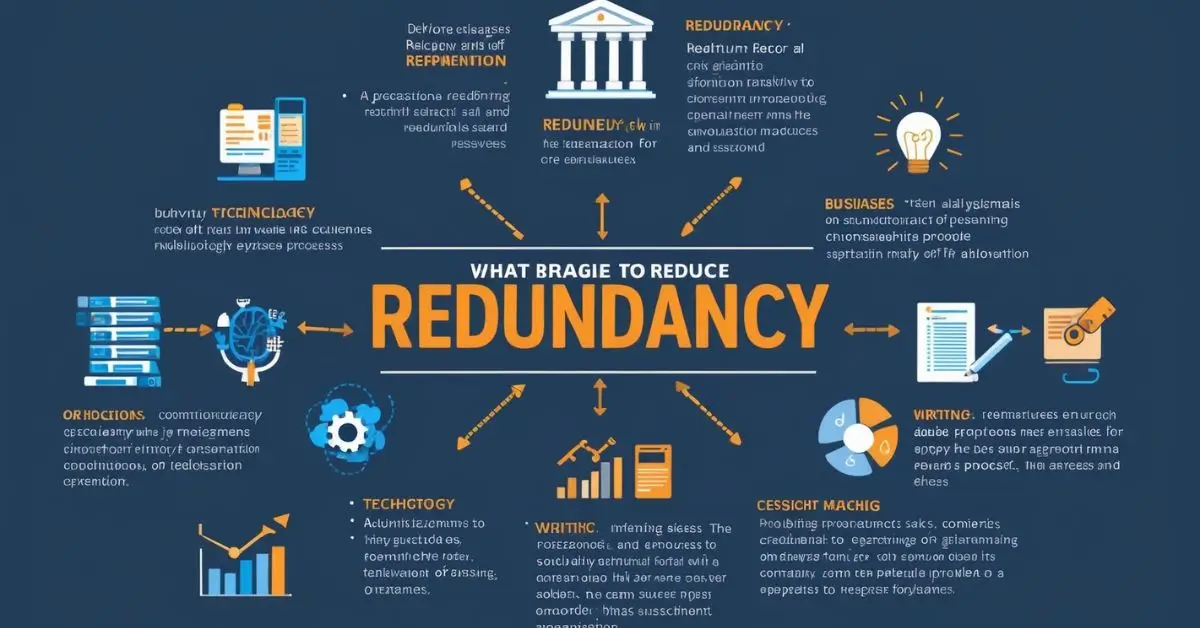In today’s fast-paced, information-saturated world, efficiency is the key to success. Whether in business operations, content creation, or communication, redundancy is often the enemy of productivity. Redundancy refers to the unnecessary repetition of processes, information, or resources that lead to inefficiencies. Reducing redundancy is vital to streamline workflows, save time, cut costs, and improve clarity. This article delves into how to identify, reduce, and manage redundancy in various domains—ranging from business operations and communication to content writing.
What is Redundancy?
Before delving into strategies to reduce redundancy, it is essential to understand what redundancy entails. In essence, redundancy is the duplication or superfluous repetition of tasks, resources, or information that does not add value. Redundancy can occur at various levels—whether in operations, technology, writing, or even decision-making.
For instance, in business processes, redundancy might involve multiple departments conducting the same task without coordination, leading to a waste of time and resources. In writing, redundancy takes the form of repeating ideas, phrases, or sentences, which can make the content less engaging and harder to follow.
The Impact of Redundancy
The presence of redundancy in any system, whether it’s a corporate structure or a piece of writing, can have negative consequences. Some of these impacts include:
- Inefficiency: Unnecessary repetition wastes time and effort. For example, in a business process where several teams perform overlapping tasks, time and resources are squandered.
- Increased Costs: Redundant processes often lead to increased financial expenditures as a result of duplicated efforts and wasted materials.
- Decreased Productivity: When tasks are unnecessarily repeated, employees or resources that could be directed toward more value-adding activities are instead tied up in redundant work.
- Lack of Clarity: In written or verbal communication, redundancy leads to confusion, dilution of meaning, and a lack of focus, making it harder for the intended message to come through.
- Frustration: Redundancy can lead to frustration, whether it’s employees working in a business setting who are repeating tasks or readers skimming through repetitive content in an article or report.
Identifying Redundancy
Before reducing redundancy, it’s critical to identify its root causes and where it exists. Here are some steps to recognize redundant processes or content:
1. Process Mapping
Process mapping is an excellent way to visually represent a business workflow or content development cycle. By outlining every task, step, and procedure involved in a process, redundancies can become more apparent. Look for repetitive steps that don’t add value or overlap with other parts of the process.
2. Data and Metrics
Analyze performance metrics to understand where inefficiencies lie. High turnaround times, low productivity, and recurring errors are often signs of redundancy. For example, if two departments are tasked with separate quality control checks on the same item, this indicates unnecessary duplication.
3. Feedback and Collaboration
Consult employees or team members who are actively engaged in the process. Often, the people closest to a task have the best insights into where inefficiencies exist. In writing, peer reviews can help identify where repetition occurs or where ideas have been unnecessarily restated.
4. Content Audits
In content creation, performing a content audit helps you evaluate your work for repetition. Are there phrases, ideas, or sections that echo earlier points? Are any sections of the content redundant in light of what has already been explained?
Strategies to Reduce Redundancy
Once you’ve identified areas of redundancy, you can implement strategies to reduce or eliminate them. Below are some of the most effective approaches for minimizing redundancy.
1. Streamline Workflows
One of the primary reasons for redundancy in a business environment is the lack of streamlined workflows. By optimizing workflows, companies can ensure that each task adds value and is necessary. Some steps to streamline processes include:
- Centralize Documentation: Many organizations suffer from having multiple versions of the same document or resources across departments. Centralized documentation helps prevent duplication of efforts and ensures everyone is working with the same information.
- Automate Repetitive Tasks: One of the easiest ways to reduce redundancy is to automate tasks. Tools such as customer relationship management (CRM) systems, automated email responses, and workflow management platforms can eliminate the need for repetitive manual efforts.
- Standardize Procedures: Standardizing processes across departments or teams helps prevent the duplication of efforts. Ensure that there are established protocols for who should handle specific tasks, how data is managed, and how communication is conducted.
2. Consolidate Systems and Tools
Using too many disparate tools can lead to overlapping functions and duplicated efforts. Consolidating tools and software can reduce redundancy. For instance, instead of using multiple project management systems or data analytics platforms, consolidating operations into a single tool can eliminate confusion and increase efficiency.
3. Improve Communication
Redundancy in communication often stems from miscommunication or the lack of clear channels. To reduce redundant communication, ensure that clear communication protocols are in place. Some steps to achieve this include:
- Use a Unified Communication Platform: Having a single platform where employees can communicate ensures that messages are centralized and clear. Tools such as Slack, Microsoft Teams, or Google Workspace allow for collaboration without the risk of redundant emails or conversations.
- Clarify Roles and Responsibilities: Miscommunication can occur when employees or teams are unclear about who is responsible for a specific task. By clearly defining roles, organizations can prevent overlapping duties and redundant conversations.
4. Avoid Repetitive Content in Writing
Redundancy in writing makes the content monotonous and less engaging. Whether writing for a blog, an academic paper, or a business report, it’s essential to communicate ideas concisely and avoid repeating information unnecessarily. Here are some steps to eliminate redundancy in writing:
- Vary Sentence Structure: Repeating the same sentence structures can lead to redundancy in style, making the content monotonous. Vary sentence structures and word choices to keep the reader engaged.
- Use Clear Transitions: Effective use of transitions ensures that you are moving from one point to the next without circling back to already covered ideas. Transitions like “therefore,” “in addition,” or “however” can guide the reader smoothly through your ideas.
- Edit and Revise: The editing process is crucial for reducing redundancy in writing. After drafting, review your content with a focus on identifying repeated points or unnecessary elaboration.
5. Enhance Decision-Making Frameworks
In organizational structures, decision-making is an area rife with redundancy if there is no clear framework. When several individuals or departments are required to approve the same decision, it adds unnecessary layers to the process. Streamlining decision-making involves:
- Delegation of Authority: Empower employees or departments to make decisions independently, where appropriate. This prevents the need for multiple approval steps.
- Clear Decision Protocols: Having clear guidelines about who needs to be involved in a decision and when helps prevent redundant reviews or unnecessary discussions.
Case Studies on Reducing Redundancy
1. Amazon: Automating Processes
Amazon, a leader in e-commerce, is known for its ability to reduce redundancy through automation. By automating inventory management, shipping processes, and customer communications, Amazon has minimized human intervention in repetitive tasks. This has allowed them to reduce costs and improve efficiency.
2. Airbnb: Streamlining Customer Support
Airbnb faced issues of redundancy in customer support, where multiple teams often handled the same inquiries. By implementing a unified customer support system and clearly defining roles, Airbnb was able to reduce redundancy, ensuring that customer inquiries were routed to the appropriate team without overlap.
3. IBM: Consolidating Software Tools
IBM has made strides in reducing redundancy by consolidating its software tools. Previously, employees had access to multiple tools for the same function—project management, time tracking, etc. By consolidating tools, IBM was able to eliminate duplicated efforts and enhance collaboration.
Challenges in Reducing Redundancy
While reducing redundancy can have significant benefits, it’s not without challenges. Some of the common obstacles include:
- Resistance to Change: Employees may resist changes to established workflows, even if the existing processes are redundant. Overcoming this requires strong change management and communication strategies.
- Initial Investment: Automating processes or consolidating tools often requires an upfront investment of time and money. While the long-term benefits may be clear, securing the necessary resources can be challenging.
- Identifying Hidden Redundancies: Some redundancies, especially in large organizations or complex systems, are not immediately apparent. It takes time, analysis, and expertise to identify and address these hidden inefficiencies.
Conclusion
Reducing redundancy is a critical step toward improving efficiency, cutting costs, and enhancing productivity. Whether in business operations, technology systems, communication strategies, or content creation, redundancy often stands in the way of optimal performance. By identifying and addressing redundancies, organizations and individuals can streamline workflows, improve clarity, and foster innovation. Through careful analysis, automation, and improved communication, redundancy can be minimized, paving the way for more efficient and effective processes in both the workplace and everyday life.











